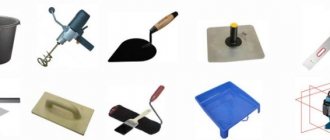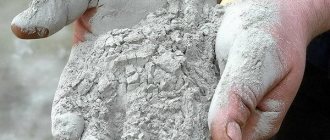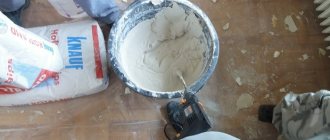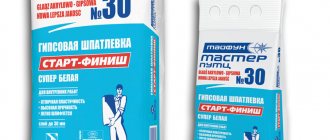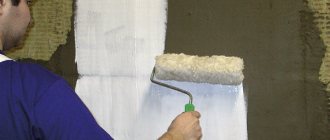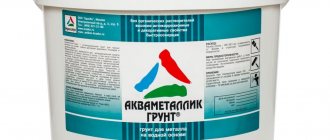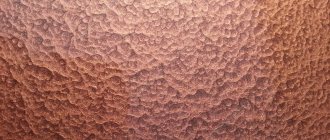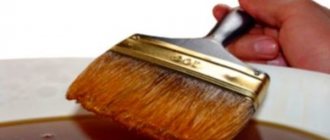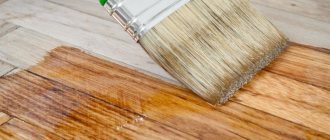When doing renovations, it is not enough to purchase finishing materials. It is important to use them correctly to ensure maximum adhesion. When performing repairs yourself, problems arise with the finishing coatings lagging behind the treated surfaces of walls and ceilings. Inexperienced builders will witness peeling plaster, peeling tiles, peeling wallpaper. A special primer - concrete contact - will help solve a serious problem, providing an increased degree of adhesion of finishing materials to the surface.
What is concrete contact
Not everyone knows what it is. The popular concrete contact, the use of which ensures increased adhesion of finishing materials to walls and ceilings, is a special mixture for priming the surface being treated.
This primer is intended for surfaces that do not absorb moisture well.
The soil contains the following ingredients:
- Portland cement.
- Quartz sand.
- Polymer filler.
- Special additives.
Concrete contact is a polymer-based building mixture that is resistant to alkalis and increases the adhesion of the material to the base.
Concrete contact - application
Concrete contact is used for various purposes when performing construction and repair work:
- Indoor treatment of concrete wall and ceiling surfaces intended for plastering work.
- Coatings of facade walls of buildings intended for applying decorative coatings.
- Treatment of the bases on which the finishing tiles will be installed.
- Priming the surface for wallpapering or painting.
The composition is supplied ready for use in sealed packaging. Having purchased a concrete contact, you can begin using it immediately after opening the lid.
It can be applied with a roller, brush or spatula
Why is it needed?
The main purpose is to provide strong adhesion between two materials and strengthen the base. Improving adhesion is necessary not only on the ceiling and walls, but also when installing floor screed. Concrete contact is used both under concrete and cement-sand screeds, and under self-leveling floors. As a result, the finished surface is not scattered layers, but a solid and durable structure.
On concrete wall slabs, which are characterized by a particularly smooth surface and poor moisture absorption, the use of such a solution is mandatory. Without it, it will not be possible to carry out the work of plastering or painting the wall. The finishing materials will not stick or will quickly crack and fall off from such a surface, and the wallpaper simply will not stick.
Concrete contact is a convenient modern replacement for wall banding , which was used in the Soviet and post-Soviet periods. To create this design, the entire surface of the walls was covered with a fabric mesh. For gluing, regular PVA glue was used. This method was not only difficult, but also did not always lead to the desired result.
By using concrete contact it is also possible to save yourself from labor-intensive and expensive work on cleaning the surface of the old coating. This mixture can be applied to oil paint and tiles. In this case, the quality of the final result will be no worse than when applied to a surface cleaned of them. All that remains is to strictly follow the manufacturer’s instructions, follow the technology of use and complete all work within the specified time frame.
In addition to good adhesion to the surface, improved adhesion and versatility, concrete contact has another important feature. After the composition dries, a waterproofing layer is formed on the surface, which will not be superfluous for both internal and external work. But this quality is especially important for preserving plastered surfaces for the winter. Under the concrete contact layer, the plaster coating will remain as smooth and dry as it was before the frost.
USING CONCRETE CONTACT
You can work with the primer in the same way as with conventional strengthening solutions. Any self-respecting manufacturer of concrete contacts describes the use of the solution in short instructions included with the packaging.
Most often, the primer is sold ready-made; in this case, to use it you just need to clean the wall of mechanical impurities and start applying the primer to the surface. Sometimes powder forms of concrete contact are used, especially when working with large volumes of priming. According to the instructions, the finished concrete contact is stored without loss of technical characteristics for a year, dry mixtures are designed for use after a longer storage period.
Concrete contact is always made on a water basis, so during long-term storage some of the water may evaporate. Before use, or even better, upon purchase, experts recommend opening the package and inspecting the surface of the liquid concrete contact. If there are traces of a dried layer with cracks on the walls of the container, it is better to postpone the use of such a solution. It is always necessary to check the suitability of concrete contact for use based on its expiration date.
Scope of application
Concrete contact is especially necessary when finishing ceilings to protect the layer of material from peeling off under its own weight. Previously, a special mesh was used for this purpose, but now this is not necessary.
There are no restrictions on the place of use; the primer is quite suitable for outdoor use.
There is no need to completely remove old cladding, including oil paints and tiles.
The composition of such mixtures is natural, there are no obstacles for use in a children's room and other institutions.
Material Specifications
At the moment, there are four most important technical characteristics of this material that affect the quality of the work performed:
- Durability - the technical characteristics of concrete contact indicate that the properties of the composition are maintained for eighty years. For interior decoration of the premises, this period is more than enough, since repair work is usually carried out with much less frequency.
- Drying time – after applying the concrete contact, if the instructions are followed, the surface is ready for further finishing within two to three hours.
- Resistance to moisture - concrete contact, in fact, creates additional waterproofing, since when applied to the surface this composition forms a waterproof film.
- Material consumption is the approximate consumption rate of concrete contact per square meter. a meter is between two hundred and four hundred grams. It should be borne in mind that these indicators are very conditional and vary depending on the technical characteristics of the composition itself, as well as on the characteristics of the surface being treated.
Properties of concrete contact
The mixture is characterized by increased performance characteristics:
- fastens the base, which is covered with soil;
- contacts with smooth, non-absorbent substrates, forming an adhesive layer;
- does not contain harmful ingredients;
- does not emit unpleasant odors;
- used to cover substrates located indoors and outdoors;
- contains a dye that facilitates visual inspection during coating;
- applied manually or mechanically;
- supplied prepared;
- dries quickly, which allows you to continue further work after two to three hours;
- can be used for a long period (more than 50 years).
forms a waterproof layer on a primed base, providing reliable waterproofing;
The high performance properties of concrete contact were appreciated by professional builders who use modern primers.
Main characteristics of "Betonokontakt"
Obviously, the areas in which the Betonokontakt primer can be used are not unlimited, but the choice is large.
- Applying a primer to the surface increases the “roughness”. Which in turn increases the area of contact between the surface and finishing materials. This ensures the most reliable adhesion of materials with different properties.
- The surface primed with Betonokontakt dries quickly. In just two or three hours you can continue finishing work.
- “Betonokontakt” is extremely moisture resistant. This is achieved by forming a kind of waterproof film on the surface during the drying process. It is this film that prevents moisture from penetrating into the deep layers of surfaces. Thanks to this, “Betonokontakt” has found its application as a waterproofing material in the manufacture of floor screeds.
The screed is treated with concrete contact before the self-leveling floor - The coverage guarantee during operation reaches eighty years.
- For ease of use, the material contains color additives. This allows you to more carefully monitor the process and thickness of applying the primer to the surface.
- "Betonokontakt" is completely universal in terms of application. This process can be performed either manually or mechanized.
- The material is easy to use. This allows it to be actively used not only by professionals, but also by beginners in the matter of repairs.
Scope of application of concrete contact
- Concrete contact primer is used on any surfaces that are unable to absorb moisture normally. Since the concrete surface absorbs moisture quite poorly, any construction mixture has poor adhesion to the surface. Treatment of the ceiling surface in this case involves the use of only a primer.
- Until recently, qualified specialists, in order to prevent premature falling off of the plaster, applied a special product - a fabric mesh of the required size was glued to the surface using PVA, after which they continued to apply a layer of plaster.
- This whole procedure took a certain period of time and required special skills. The use of concrete contact primer greatly facilitates the work of craftsmen. In addition to the speed of application, this product is also distinguished by its durability and reliability.
- It is also worth noting that the above-mentioned primer can be used both indoors and outdoors. As a rule, it must be applied before starting surface finishing work - applying decorative plaster, installing tiles or decorative stone.
- The unique properties of the primer composition allow it to be applied to surfaces of any configuration and complexity. The processed surface acquires a peculiar texture, which provides high adhesion.
Is concrete contact necessary over oil paint?
Finishers also use Betonkontakt over oil paint. Most people advise removing the paint anyway, because both with and without concrete contact, the plaster under its own weight can separate from the paint. If the composition is firmly ingrained and cannot be removed by any means, you must:
- Be sure to thoroughly degrease the surface.
- Remove smoothness using abrasive treatment - coarse sandpaper or a wire brush. It doesn’t matter what, as long as it works.
- Make notches using a chisel or axe.
Please note that some manufacturers position their Betokontakt only for interior work
- Remove dust. You can wash it, you can vacuum it. The main thing is to be thorough.
- Apply the first layer of concrete contact.
- Dry.
- Apply a second layer of concrete contact.
- Dry.
- You can putty, plaster, lay tiles.
In this case, it is also clear why Concrete Contact is needed and how it works. But it is quite possible to stop before the first application of Concrete Contact. If there are notches of sufficient area, both the plaster and the tile will stick. Use a suitable primer to fill any “chips” in the wall and, once dry, apply the next material.
Olimp has designated its Contact-Grunt as a product for decorative plasters and ceramic tiles
Many people assume that the sticky surface that Betokontakt leaves will hold better. In general, it works, but only if you do everything as written. And yes. Drying is complete and final. The expiration date is indicated on the can and differs depending on the manufacturer. The shortest drying period is 3-4 hours for Betonkontakt Fedal, the longest is about 24 hours for some cheap ones.
Purpose and scope
Concrete contact is a special type of primer for substrates that do not absorb water. If plaster is applied to such bases without prior preparation, it will most likely fall off when drying, since the surface of these bases is usually smooth and there is simply nothing for the plaster to cling to. To prevent the plaster from falling off, use Beto-contact. And it really works, but you just need to know when it is needed.
Operating principle of Concrete Contact
The composition is not cheap, and it is recommended to use it anywhere. In order not to waste your money, you should know exactly its properties and scope of application. In general, information is on each can, but sellers (and some builders) advise a different use. But not everyone needs to be trusted.
What surfaces to apply to?
Concrete contact forms a sticky, rough layer with abrasive inclusions on the surface. Plaster/putty also adheres well to this layer. Abrasive particles - grains of sand or crystals - provide additional support for the finishing layer. In general, the task of Concrete Contact is to increase adhesion to complex substrates. But not to everyone.
What should Betonkontakt be applied to? As already mentioned, it is intended for substrates that do not absorb water. There are not many of them:
- Smooth concrete that is almost poreless. Usually these are concrete panels in panel houses, columns in modern monolithic ones. If the concrete is loose and porous, a different primer is needed.
Betokontakt from Knauf has a pink dye in its composition. - Ceramic tile. It is not necessary to knock down the old tiles when laying new tiles. Although, if possible, it is better to shoot it down. If for some reason this cannot be done, go over the top of the tile twice with concrete contact and you can continue working.
- Wooden fragments. There is simply no other way to apply plaster to wood. But the wood must be dry.
- Metal. This base is 100% non-absorbent of moisture and in order for the plaster to stick to it, a layer of BC is needed.
This is what Concrete Contact is for. There are no other recommended surfaces. Advice to apply on plaster under putty, under decorative plasters is all unnecessary. There is no need for this processing, because only the cost increases, but does not affect the result or only worsens the situation. Putty will work great on fresh plaster, just like other finishing materials.
Option from Prospectors - Beton-Contact
There is one piece of advice: it is better to use concrete contact with coarse grain if you apply plaster and with fine grain for putty.
Moreover, the advice to apply Betokontakt to wooden and metal surfaces is specifically for fragments. For example, beams, protruding parts of structures. This is again the moment where a bookmaker is needed. There are other technologies for plastering wooden walls, and if there is only a fragment, it is advisable to use this composition.
Is concrete contact necessary over oil paint?
Finishers also use Betonkontakt over oil paint. Most people advise removing the paint anyway, because both with and without concrete contact, the plaster under its own weight can separate from the paint. If the composition is firmly ingrained and cannot be removed by any means, you must:
- Be sure to thoroughly degrease the surface.
- Remove smoothness using abrasive treatment - coarse sandpaper or a wire brush. It doesn’t matter what, as long as it works.
- Make notches using a chisel or axe.
Please note that some manufacturers position their Betokontakt only for interior work - Remove dust. You can wash it, you can vacuum it. The main thing is to be thorough.
- Apply the first layer of concrete contact.
- Dry.
- Apply a second layer of concrete contact.
- Dry.
- You can putty, plaster, lay tiles.
In this case, it is also clear why Concrete Contact is needed and how it works. But it is quite possible to stop before the first application of Concrete Contact. If there are notches of sufficient area, both the plaster and the tile will stick. Use a suitable primer to fill any “chips” in the wall and, once dry, apply the next material.
Olimp has designated its Contact-Grunt as a product for decorative plasters and ceramic tiles
Many people assume that the sticky surface that Betokontakt leaves will hold better. In general, it works, but only if you do everything as written. And yes. Drying is complete and final. The expiration date is indicated on the can and differs depending on the manufacturer. The shortest drying period is 3-4 hours for Betonkontakt Fedal, the longest is about 24 hours for some cheap ones.
Costs of concrete contacts of different brands - is there a difference?
The consumption of concrete contact from a wide variety of manufacturers depends, firstly, on such qualities of the treated surface as:
- porosity;
- absorbency.
In Table 1 you can see the consumption rates of concrete contact for surfaces of different structures.
Table 1
Table 1
It can be seen that any primer per 1 m2 is consumed approximately the same.
There is a way to slightly reduce the consumption of concrete contact for porous surfaces - preliminary impregnation with a deep penetration primer and an antiseptic. Secondly, you need to keep in mind the influence of the size of the sand, expanded clay or marble chips included in the composition:
- concrete contact with fine-grained (0.3 mm) filler is applied in a thin layer;
- compositions with coarse-grained particles (0.5-0.6 mm) - thicker, about 1.5 - 2 times larger.
Thirdly, the consumption is influenced by the characteristics of the recipe of each specific manufacturer. You can compare the average consumption values depending on the brand of concrete contacts in Table 2.
table 2
table 2
As you can see, there is a difference, although not very big.
To accurately determine the consumption rate, the probe method is used:
- a certain amount of concrete contact soil and the tool with which it will be applied is weighed;
- a square meter of surface is marked out (with chalk or adhesive tape) and covered with soil to the required quality;
- the remaining solution and tools are weighed;
- find the difference in the scale readings - how much is the consumption rate;
- the resulting value is simply multiplied by the total area to be processed.
Instructions for the use of concrete-contact primers
Before finishing the walls and ceiling, you need to carefully prepare the surface. To ensure that the topcoat adheres well, use a primer. Previously, builders primed in different ways, but we see that the paint and tiles have begun to peel off or have already fallen off. In cheap new buildings, workers sin with minimal primer consumption, which also leads to dire consequences.
Concrete contact will help to prime properly and for a long time. Not all builders want to work with him, as they have heard different stories and are not ready to part with proven methods. But practice proves that real BC is better than a regular primer if you follow all the rules for its use. The hardened surface of concrete becomes smooth, and therefore it has low adhesion, that is, the ability to bond. This is why tiles, plaster and paint fall off quickly. Concrete contact is a special type of primer that promotes better contact between the finish and the smooth surface of concrete, old tile or paint. BC contains small particles of quartz sand, which increase the adhesion of the base and finishing material.
The technical characteristics of the concrete-contact primer depend on the composition. There are primers with sand fractions of 0.3 and 0.6 mm. The finer the grains of sand, the less consumption will be. The choice is influenced by the area of application: for putty, BC with fractions of 0.3 mm is sufficient, and for plaster - 0.6. This primer is made on the basis of acrylic, which avoids a strong odor, and it also dries quickly. Usually the bookmaker is pink, so unscrupulous employees cannot save money on it. After all, there are often cases when the primer is heavily diluted with water or applied loosely. Tex offers BC that reddens the surface so you can control the uniformity.
Features of application
Home-grown builders do not know that each primer has a limited area of application. The price of concrete-contact is higher than that of a regular primer, so before purchasing, figure out whether you need to increase the contact between the coating and whether the base absorbs moisture. To do this, sprinkle water on the surface; if the liquid is not absorbed or is absorbed only slightly, the use of concrete contact will be justified. If the base is rough, a deep penetration mixture is better and costs less.
In some stores, sellers position concrete contact as a miracle primer that is used for brick, old plaster and putty, but this is not so. If your brick is completely smooth, they may be right. Otherwise, look for another primer. Read the description on the package; this is often more useful than consulting with an ignorant person. The characteristics of concrete-contact are such that its use is justified only for smooth and almost non-moisture-absorbing surfaces.
Types of bases:
- monolithic concrete and blocks;
- old tiles;
- oil or alkyd paint.
Types of coatings:
- gypsum, gypsum-limestone plasters and putties;
- tile adhesive.
If you need to treat different surfaces inside and outside, the concrete-contact Universal primer is suitable for you. The BC produced by the company Starateli will withstand the street environment. It contains additives that increase moisture, frost resistance and antiseptic properties. If the amount of work is large, by choosing the appropriate composition, you will not only strengthen the base and extend the service life of the finish, but also save money.
Large companies develop primers specifically for their materials. This does not mean that it is necessary to use products from the same manufacturer, but if you have such an opportunity, take advantage of it. The companies Starateli and Knauf have lines of building materials. Such products are tested together.
Application technology
1. Do I need to prepare the surface?
Remove old coating if possible. It is convenient to clean plaster and putty with a wire brush; the whitewash must also be removed. Clean the base from excess grease with baking soda or detergent. This way nothing will interfere with reliable contact between the primer and the base.
2. Is contact concrete diluted with water?
In no case, this is a violation of operating technology. Before use, mix the primer thoroughly with a mixer so that there are no lumps in it.
3. How many layers can I apply?
1-2 layers will be enough.
4. What is more convenient to apply?
The use of a roller or mechanical spray allows you to reduce consumption and perform better work. You can also use a brush or spatula if necessary.
5. What is the consumption per 1 m2?
The average consumption of concrete-contact is 0.2-0.5 kg. The higher the moisture absorption of the material, the more primer you need to use.
- For monolithic concrete and concrete slabs - 0.35-0.2 kg.
- For tiles - 0.15-0.25 kg.
6. At what temperature is it used?
The temperature must be above +5 and below +25 °C. It is better to clarify this information on the packaging, since the characteristics of concrete contact vary depending on the manufacturer.
7. After what time can I continue?
It all depends on the manufacturer, the average drying time is 6 hours. But it is better to start subsequent work within 24 hours so that dust does not appear on the surface. Immediately rinse brushes and rollers with water. Once dry, high-quality concrete contact will be difficult to clean off.
Price
| Firm | Packaging, kg | Price, rubles |
| Tex | 13,5 | 1 300 |
| Ceresit CT 19 | 15 / 3 | 800 / 400 |
| Prospectors | 20 / 5 | 1 400 / 420 |
| Knauf | 20 / 5 | 2 500 / 600 |
The table shows the average prices for bookmakers according to the end of 2015. Do not buy mixtures from expensive manufacturers at low cost. Unfortunately, there are many counterfeits on the Russian building materials market, so it is easy to buy BC with the characteristics of a regular primer or even worse. Sometimes you can come across a high-quality product from lesser-known companies at a low price, but before purchasing, read the reviews, or better yet, do a test primer.
Do not skimp on the primer; it will be a shame if a piece of the wall flies off from drilling or hitting with a hammer. Look at the expiration date, it usually ranges from 6 months to 1 year, and product certificates. If you need to do a large amount of work, buy one package and test it on a small area of the surface.
How to buy concrete contact and not go broke on construction
Not a single professional will advise saving on priming surfaces with concrete contact. In order for the plaster, glue or topcoat to last long and firmly, the layer of such primer must be applied evenly, without gaps and have sufficient thickness. The greater the thickness of the concrete contact layer, the better its adhesive properties are manifested. There is no point in saving here - you can lose much more by spoiling, for example, not cheap drywall, tiles and other materials that have fallen off.
The sufficiency of the thickness of the covering concrete contact is determined simply: you need to run any spatula over the dried surface, and if the sand particles crumble, you need to apply another layer.
The cost of concrete contacts on the Russian market varies greatly, so the average price will not make much sense.
You can buy high-quality concrete contacts much cheaper from domestic manufacturers, especially since high cost does not always mean better quality. Often the price of concrete contact per 1 m2 is no more than 10 - 20 rubles (one-time coating).
Attention! Due to the fact that there are often counterfeits of the product or failure to comply with storage standards, an important question is: where to buy concrete contact? The answer is only from reliable suppliers, in specialized stores with stable temperatures, or through the manufacturer’s website.
Based on the consumption rates, it turns out that a 10-liter can of concrete contact is enough to cover 20 - 50 square meters. meters of surface.
If you also take into account the service life of the coating, it turns out that it is not that expensive.
FEATURES OF APPLYING PRIMER
Before use, it is recommended to mix the finished mixture thoroughly until smooth. During storage, the solution may separate, and this does not mean it is defective or unsuitable for use. The mixture contains substances of different densities; heavier cement and quartz filler can settle to the bottom. When applying unmixed soil, a pattern of uneven saturation is formed on the wall; accordingly, the adhesion strength to cement will also be different.
During preparation, the wall should be checked with a spatula for the presence of peeling, dirt, oil stains and deep cracks. Small cracks are not particularly dangerous for the use of concrete contact; thanks to the adhesive base, the primer thoroughly strengthens the surface layer.
The best option for applying concrete contact is to use a foam paint roller or a wide brush; in both cases, the soil is applied evenly and is well controlled due to the specific tinting. Most often it is white, although Krauf products use more expressive pink shades that cannot be confused with other primers.
The consistency of concrete contact is similar in viscosity to liquid sour cream or thickly grated paint; the soil is easily held on a brush or foam roller surface. When applying concrete contact, the best method is the sequential use of short vertical and horizontal strips. The optimal temperature for concrete contact is from +5 to +30°C. The instructions do not recommend using soil at higher or lower values due to the violation of the drying regime. In cold weather, concrete contact turns into a viscous mass that is completely impossible to work with.
The drying time of the layer is from 2 to 4 hours, but for a more complete use of all the benefits of the primer, experts advise not to wait and start plastering work after 2.5 hours.
The minimum recommended time is at least 2 hours; during this period, the use of any equipment in the room that generates dust or mist should be avoided.
Features of application
https://www.ceresit.ru
The primer is sold in plastic buckets with a sealed lid. Containers often have a volume of about 3, 5 and 50 liters. Before applying concrete contact, the contents of the container must be thoroughly mixed until smooth. During operation, it is recommended to repeat the procedure periodically, since the mineral component settles to the bottom.
To monitor the uniformity of primer application, manufacturers add special pigments to the initially transparent composition. They do not affect the quality of the dry residue, but make the work easier. So, some materials are pink or blue. Others, like those from Tex, change shade as they penetrate and dry.
On what surfaces is it applied?
The property for which the Betonokontakt primer is valued: application for any surface. It can be mineral, wood, polymer, metal or glass. The acrylic binder component has sufficiently high adhesion to ensure reliable adhesion of the soil to a smooth, dense surface.
Note! Before applying the quartz primer, the metal must be treated with an anti-rust compound and the wood must be dried. A two-layer coating is formed over the ceramics. In the case of glass and plastic, it is important to apply a special primer and correctly calculate the load from the planned finish. It should be less than the pull-out strength of the soil-to-base connection.
If you plan to prepare a brick surface, then you need to read the instructions for the specific concrete contact. Some compounds are not recommended to be applied to masonry, since blocks and grout have different structures and absorbency.
Sometimes the manufacturer indicates the applicability of the primer coating for finishing with putty. This implies the permissibility of only a rough type of leveler, the layer of which must exceed the fraction of solid filler in the primer. Finishing pastes and mixtures have limits of 1-2 mm.
Kinds
The main difference between the types of concrete contact is the size of the quartz sand particles, which determines the choice of surface for treatment with this mixture. In addition, there are primers that are intended only for indoor use, and a combined primer for external and internal use. The packaging of the primer composition always contains instructions describing the materials suitable for processing. It is worth trying to take into account the manufacturer’s recommendations, this will reduce primer consumption and obtain the desired result.
The following components must be present in the concrete contact:
- Cement or Portland cement;
- Fine quartz filler;
- Polymer, most often acrylic, component;
- Special technological additives.
The technical characteristics of the composition do not depend on the manufacturer or type of mixture and are always the same:
- Environmentally friendly. The composition does not have an unpleasant odor or harmful fumes. To work with it, personal protective equipment for hands and respiratory tract is not required.
- Resistant to alkalis and aggressive environments.
- Waterproofing properties.
- It allows gases to pass through, which creates proper air circulation in the room and prevents the formation of mold.
- Resistance to parasites, mold and fungi.
- Drying speed at room temperature and moderate humidity is only 2-3 hours.
- The service life declared by the manufacturers is 80 years. After this period of time, the concrete contact layer begins to collapse.
- Air temperature for work is 5-35°C, recommended humidity is 60-80%.
To make it easy to control the thickness of the layer and the uniformity of the coating, manufacturers add white or pink dye to the mixture, which is clearly visible on the surface being treated. Without dye, contact concrete is a clear liquid.
The solution can be applied to any surface either manually or mechanically using a compressor or spray gun. There are options for using mechanical devices; this must be indicated in the instructions. In addition, specialized stores have a selection of mixtures in aerosol cans.
Any type of concrete contact must comply with GOST 28196: according to its characteristics, it refers to water-dispersed compositions with acrylic copolymer. If the GOST number indicated on the packaging is different, it is better to refuse such a purchase.
The consumption of the mixture per 1 m² depends not only on the size of the sand particles, but also on the porosity of the treated surface:
- for a smooth and slightly porous surface, such as a painted wall, metal and glass bases, ceramic tiles, the mixture consumption will be about 150 g/m².
- for a medium-porous surface made of concrete slabs or finishing bricks, the consumption will range from 300-350 g/m².
- for a highly porous surface, such as concrete or building brick, the consumption can be 500 g/m² or more; To reduce the consumption of concrete contact, the surface is coated with a deep penetration primer.
Concrete contact is sold ready-made in containers of 3, 5, 20 and 50 liters. To get started, you just need to open the lid and mix the composition so that the quartz filler is evenly distributed throughout the mixture. Stirring must also be repeated periodically during operation.
Before starting to apply the mixture, the surface to be treated is carefully prepared:
- a coating that does not adhere well to the base must be beaten off or scraped off;
- remove grease stains, glue and bitumen drips;
- Clean the surface from dust and wait for it to dry completely.
Please note that the base must be treated with concrete contact immediately after it has dried. If a new layer of dust settles, cleaning will have to be repeated again. Concrete contact does not adhere only to dusty and greasy surfaces.
You need very few tools to apply the mixture:
- wide brush, roller or spray gun;
- stick for mixing the composition;
- container with concrete contact.
You can apply concrete contact with a roller, but it is better to replace it with a wide brush. This way you can achieve a more even coating and better penetration of the composition into all the cracks and pores in the base. The mixture can be diluted with water, but only in cases where mechanical methods are allowed for application: this possibility is indicated in the manufacturer’s instructions.
On the contrary, it is better to prime a painted wall or drywall with a roller. With other methods, you can get a layer that is too thin and weak. The brush and stained surfaces should be thoroughly washed immediately after completing all actions. Uncured concrete contact can be washed very easily, but the hardened composition cannot be removed.
3-4 hours after applying the primer, it would be a good idea to check the quality of the resulting coating. It is easy to determine from the dried layer whether there are gaps or places where the primer has been completely absorbed. If such defects are found, the surface must be coated again with the same composition. You also need to check the strength of the layer, which needs to be scraped with a knife or spatula. High-quality applied material will not fall off or deform.
It is recommended to begin applying gypsum plaster or tiling to the surface no later than 12 hours after the surface has dried. Dust quickly settles on the finished rough layer and impairs its penetrating properties. If two or more days have passed after drying, the surface must be additionally treated with a deep penetration primer.
What is concrete contact and the purpose of its use
Tongue-and-groove slabs and blocks are made from gypsum-silicate mixtures. When finished, the surface of such a slab is smooth and even, with comfortable ridges along the edges for tight adhesion of the slabs (blocks). They adhere to each other perfectly, but it is difficult to apply paint or plaster to the resulting monolith without reinforcement or notches.
A concrete slab, standing vertically or laid as a ceiling covering, also requires additional processing for further decoration. Tiles and glass do not “sit” well on ceramic, glass or iron surfaces. They slide off both silicate walls and smooth concrete surfaces. Builders come to the rescue with various mixtures that serve as a “conductor between fire and ice” - increasing the adhesion (cohesion) of materials with different characteristics.
To solve the problem “does not stick!” More recently, a bandage was used: on smooth surfaces, after applying a liquid primer using PVA or Bustilat, a fabric mesh was glued, onto which plaster, paint or adhesive solutions were then applied.
Such a bandage saved the situation for 2-3 years, then the wallpaper came off, the plaster fell off, the tiles treacherously fell under our feet at the most inconvenient moment. The essence of concrete contact is the same - it is a bandage, only the application process is much simpler and faster, and the effect is longer - from 30 to 80 years!
Concrete contact is a special thick primer that contains acrylic and other polymer fillers, quartz (marble) chips and thin cement.
The purpose of using the composition is to prepare smooth surfaces for subsequent coatings by increasing the adhesion of layers. After application and complete drying, the concrete contact forms a rough film, similar to sandpaper, due to solid insoluble particles. Plaster, ceramic and glass tiles, porcelain tiles and drywall can be easily attached to this “sandpaper” and reliably held.
The mixture itself penetrates deeply into both concrete and wood, adheres well to metal, glass and plastic, easily turning perfectly smooth surfaces into conveniently rough ones.
On video: comparison of adhesion of concrete contact and plaster.
Manufacturers
In today's market conditions, many manufacturing companies offer their own version of concrete contact. There are both very cheap and very expensive offers. The final decision on which composition to use always remains with the consumer. But still, it is better to understand the main suppliers of such goods in advance.
to , Axton concrete contacts also contain marble chips. Used for application indoors and for outdoor use. The composition is in good standing among consumers. The only drawback is complaints about high mixture consumption. The average price is 300 rubles per 6 kg.
Betonokontakt is designed for work on old tiles, on durable layers of alkyd or oil paint. It is used for both external and internal work. Mixture consumption is 200-300 ml/m². The average price is 500 rubles per 6 kg.
Concrete contact production is also suitable for work both inside and outside the building. Suitable for both concrete and smooth tiled surfaces. Available in fractions of 0.3-0.6 mm and 0.6 mm. The price for a 5 kg package is within 300-350 rubles.
Concrete contact "Bitumast" is not much different from its counterparts. Produced by KhimTorgProekt in St. Petersburg. Suitable for outdoor and indoor use. The average price is 700 rubles per 7 kg.
The concrete contact has a quartz sand fraction of 0.4 mm. Mixture consumption from 170 g/m². Suitable for both indoor and outdoor use. The average price is 400 rubles per 4 kg.
Bettokont from is also suitable for any work, but differs in increased mixture consumption. The manufacturing company indicates a consumption of 450-500 g/m². At the same time, the cost of 6 kg of the composition will not exceed 450 rubles.
The most important thing when purchasing a mixture is to shop only in specialized stores and choose products from well-known manufacturing companies. To be more confident, it is recommended to read reviews on the Internet.
Types and characteristics
Primer Concrete contact is available in the following varieties:
- acrylic;
- water-dispersed.
Acrylic (polymer) primer is environmentally friendly, safe to use, and is used for various types of work (indoor, outdoor). After treatment, the panels allow air to pass through and provide a comfortable microclimate in the room. The polymer components in the composition prevent the occurrence of mold and mildew.
The water-dispersion agent is optimal for plasterboard slabs, monolithic concrete, wooden floors, and plastic blocks. The mixture is used before painting ceramic tiles, before plastering the ceiling, tinting or gluing paper or vinyl wallpaper. Finishing material helps highlight the structure of untreated wood and brickwork.
The types of building mixture also differ in the size of the quartz sand grains. Some varieties are used for indoor work, others for external use or are universal. When purchasing a composition, it is important to take into account the manufacturer’s recommendations on the label. The composition must comply with the requirements of GOST 28196.
The technical characteristics of the building material are as follows:
- Environmentally friendly components - the primer does not contain harmful ingredients and has no pungent odors. There is no need to use hand or respiratory protection.
- The composition is resistant to alkaline components and aggressive environments.
- Good breathability of the composition ensures constant circulation of oxygen, prevents the occurrence of mold and unpleasant odors.
- Resistance to mold, parasites, fungi.
- Drying of products at average humidity is 2-3 hours.
- The service life is about 70-80 years.
- During construction work, the temperature must be maintained at +5...+35°C, the optimal humidity level reaches 60-80%.
- The composition has neutral acidity, does not react with alkali, and prevents oxidation of metal surfaces.
The mixture is intended for application manually or mechanically (with a spray gun, compressor or using aerosol cans).
Compound
When deciding the question Concrete contact - what it is, the composition of the material is taken into account:
- Cement or Portland cement.
- Fine-dispersed quartz filler - gives a rough texture to the primer, improving the quality of adhesion to the surface.
- Polymer components (acrylic dispersion, etc.) - the ingredient improves the adhesion of the mixture.
- Technological fillers and additives - impart waterproof and antibacterial characteristics to the composition.
- Dyes - add the necessary shade to the mixture, are hypoallergenic, and do not contain harmful components. Pastel colors suitable for different interiors are included as standard.
Consumption
Consumption of primer Concrete contact per 1 m² depends on the size of the sand grains and the degree of porosity of the surface to be treated:
- For smooth and slightly porous coatings (tinted walls, glass or metal, ceramic tiles), a proportion of 150 g/m² is required.
- For medium-porous coatings made of concrete or brickwork, consumption is carried out at the rate of 300-350 g/m².
- For highly porous coatings (concrete slabs, building bricks) a higher mixture consumption will be required - 500 g/m² and higher.
- To reduce the consumption of the composition, it is necessary to pre-treat the surface with soils that penetrate deeply into the structure of the materials.
Reviews
As you would expect, reviews of concrete contact are in most cases positive. There have still been no disputes about which mixture manufacturer is better. But occasionally there are negative reviews, but they are more likely about sellers, not about manufacturers.
On one of the forums, a man told a terrible story that after applying concrete contact to the ceiling and then whitewashing it, the result was not satisfactory. At first, pinkish reflections could be seen under the layer of white. And after a week, the whitewash began to chip off along with the primer.
Professional builders in this case explain that either the composition was purchased with an expired expiration date or after repeated freezing, or a fake was purchased.
Such cases, unfortunately, do occur. Therefore, if the purchase of concrete contact occurs not in a specialized store, but in the market, then it is better to open the container and check the homogeneity of the mixture. If the solution is not homogeneous, the purchase should be abandoned.
Recommendations
Concrete contact cannot be applied before plastering with a cement mixture. The peel-off strength of the film after such a primer is 0.1 MPa less than that required for cement-based mortars. Therefore, plastering with cement compositions should be carried out only on concrete.
When purchasing a primer, you need to pay attention to the production date and storage conditions. It is recommended to use only formulations that have been manufactured less than a year. If the concrete contact was stored incorrectly and was subject to freezing, there is no point in using it. After defrosting, this mixture loses its adhesive properties.
To reduce the consumption of concrete contact, the surface is pre-coated with a deep penetration primer. If the base is too dry and porous, after the first layer has dried, you need to apply the primer again. Treatment with concrete contact is possible only after the soil has completely dried.
What is concrete contact, see below.
Consumption of different types of material
Concrete contact consumption varies. This can be explained by the different fractions of the solid filler, the consistency of the soil and the absorbency of the base. Based on this, several average values are distinguished (in g/sq.m):
- 150 on a smooth base with high density (glass, metal, cement-based monolith);
- 200 for oil paint and enamel, varnished surfaces;
- 250 for tiles, porcelain stoneware;
- 300-350 for concrete slabs, brickwork, plaster;
- 500 or more for porous block structures.
Note! Compared to conventional primers, Betonokontakt costs more. Therefore, to reduce consumption in the case of highly absorbent substrates, you can pre-treat the substrate with an acrylic-based impregnating composition.
Where you should absolutely not use the composition
It is important to know not only why Concrete Contact is needed, but also where it is not needed and even harmful. For example, you should not listen to advice to saturate loose or loose substrates with the composition. This requires other deep penetration primers. And Betonokontakt sticks to a smooth surface without particularly trying to penetrate it. It makes no sense to cover whitewash, ordinary fiberboard with a loose structure, gas and foam concrete, plaster, etc.
Betokontakt is often purchased for priming a wall or floor before laying tiles. If the surface absorbs water, you should not do this. And that's why. Look at the characteristics of tile adhesive and BC. The glue has an adhesion of 0.8-0.9 MPa, and BC has an adhesion of 0.4-0.5 MPa. That is, by adding a layer of concrete contact to a normally absorbent base, you are worsening the situation at your own expense, and considerable money at that. Although some manufacturers write in the instructions that the composition can also be used for laying tiles. But the situation with adhesion is similar...
For external and internal work it can be used over old paint (written in the description)
If you want to ensure that the tiles do not fall off, take good glue. Yes, it is more expensive, but a pair of BC + cheap glue costs no less, and the result is unpredictable. If in doubt (not a very reliable base), it is better to use a deep penetration primer and/or a better adhesive. It is usually positioned “for difficult surfaces” and holds tightly, as it penetrates deeply into the base.
The use of Betokontakt will do more harm than good when applied under self-leveling floors. Cement ones will have worse adhesion than they could have, and gypsum ones will simply have to be “pulled.” They practically do not spread on the sticky base. The result is cracks, swelling and other very unpleasant moments. These are not the surfaces and cases for which Concrete Contact is needed.
Important rules and conditions for performing external and internal work Adhere to the following recommendations:
Primer, incl. intended for outdoor use, applied at a temperature of +5…+35C. In the cold the material thickens and in the heat it loses its working properties. Skin, hair and eyes are protected with protective clothing, gloves and goggles. The composition is sticky and can be removed with great difficulty when dried. Hair has to be cut. When treating the ceiling and walls from above, it is recommended to fasten a brush or roller to a 1 m long stick. This will allow the master to be at a safe distance, where drops of primer will not fall on him. It is recommended to lubricate exposed skin with a rich cream or oil so that the concrete contact is washed off more easily. Using a roller or brush, they are periodically cleaned of sand on the edge of the container. Without this, the pile will quickly clog and become unsuitable for work. During the application process, the primer is periodically stirred to lift the settled sand. If these rules are followed, the coating will be strong and durable.
What not to do
If you wish, you can find reviews or videos that say that the plaster/tiles have fallen off from Betonkontakt. To prevent this from happening, apply primer only to recommended substrates. In addition, you should not do the following things:
- Dilute the plaster or putty composition with more water than indicated on the package. Yes, it’s easier to work with, but as a result, the putty may collapse.
- Do not apply the composition to frozen ground.
- Do not apply Betonokontakt to an unprepared surface (remove all detachable parts, degrease, remove dust).
- Do not apply BC on a damp base. Dry only.
Eskaro produces a primer for non-absorbent rigid substrates with increased water resistance
- When working, do not forget to periodically mix the contents, as sand particles (granules from some manufacturers) fall down.
- You cannot continue work until the primer layer has completely dried (indicated in the instructions).
- Do not work at temperatures below +5°C. This does not mean that it cannot be used for outdoor work. It is possible, but it must be applied at positive temperatures.
- Do not allow dust to enter. It sticks very well to the adhesive surface, but then falls off along with the plaster. If the surface is dusty, another treatment is necessary.
- Do not use a composition that has expired or has been frozen. The exception is frost-resistant compounds (there are such). Before use, they must be defrosted, wait until the temperature rises above +5°C, then you can work. By the way, the inscription “frost-resistant” does not mean that it can be applied at sub-zero temperatures. It can only withstand several defrost/freeze cycles before application without loss of properties.
The German company Bergauf also has an acrylic primer Beton Kontakt
- Do not add water, even if it seems that the composition is too thick. Unless the manufacturer described this possibility in the instructions. But so far we haven’t seen any of them.
And for Betonokontakt to work, it must be “real”. There are a lot of fakes, so you have to be careful. And to be sure, you can check. Pre-treat a small piece of wall with BC according to the instructions. Apply the planned layer of plaster/putty. Wait until it dries and try to tear it off. If everything is done correctly, nothing will work out for you. They say that high-quality Betokontakt allows you to apply plaster even on glass. By the way, you can try it.
Prohibited techniques in using betocontact
There are many reviews on the Internet in which users complain about the results of using concrete contact. To avoid this, apply primer only to recommended surfaces. In addition, you should use the recommendations below.
- When diluting the solution, do not add more water than indicated in the instructions. Yes, a thinner solution is easier to apply, but as a result, the putty may fall off after drying.
- Do not process frozen ground.
- It is prohibited to apply concrete contact to an unprepared surface.
- Concrete contact is applied only to a dry surface.
- During operation, the solution must be stirred periodically, since the sand and crystals in the primer settle over time.
- The next finishing stage is performed only after the primer has completely dried, as indicated in the instructions.
- Work may only be carried out at an ambient temperature of at least +5°C. It is permissible to use concrete contact for external work, provided that the composition is applied and dried at positive temperatures.
- Avoid getting dust on the adhesive surface of the primer. If the layer becomes dusty, the concrete contact treatment should be repeated.
- You cannot use expired and frozen formulations, with the exception of frost-resistant brands. Before use, they are defrosted and waited until the material warms up to +5°C. Labeling “frost-resistant” does not mean that the material can be used at subzero temperatures. This only indicates that the primer is able to withstand several freezing/thawing cycles without losing its characteristics.
- Do not dilute the composition with water unless this is provided in the instructions for use.
- Beware of fakes. To ensure the authenticity of the composition, pre-treat a small section of the wall with concrete contact. Next, apply a layer of plaster. Let it dry and try to tear it off. If the material is of high quality, it will not be possible to tear off the plaster. There is an opinion that concrete contact from trusted manufacturers even adheres to glass. You can check it if you wish.
